Charles E W Bean, Diaries, AWM38 3DRL 606/251/1 - 1915 - 1936 - Part 14
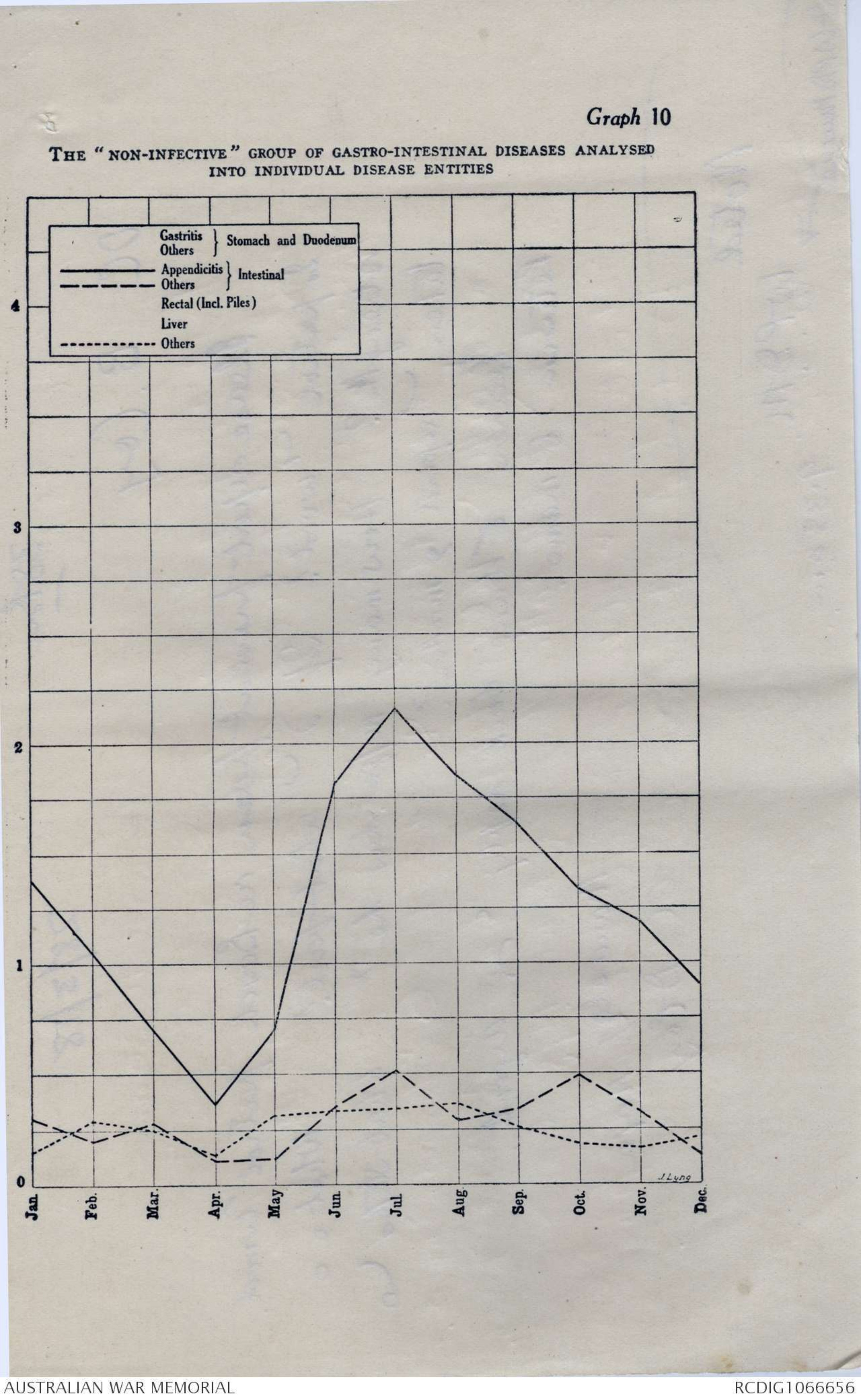
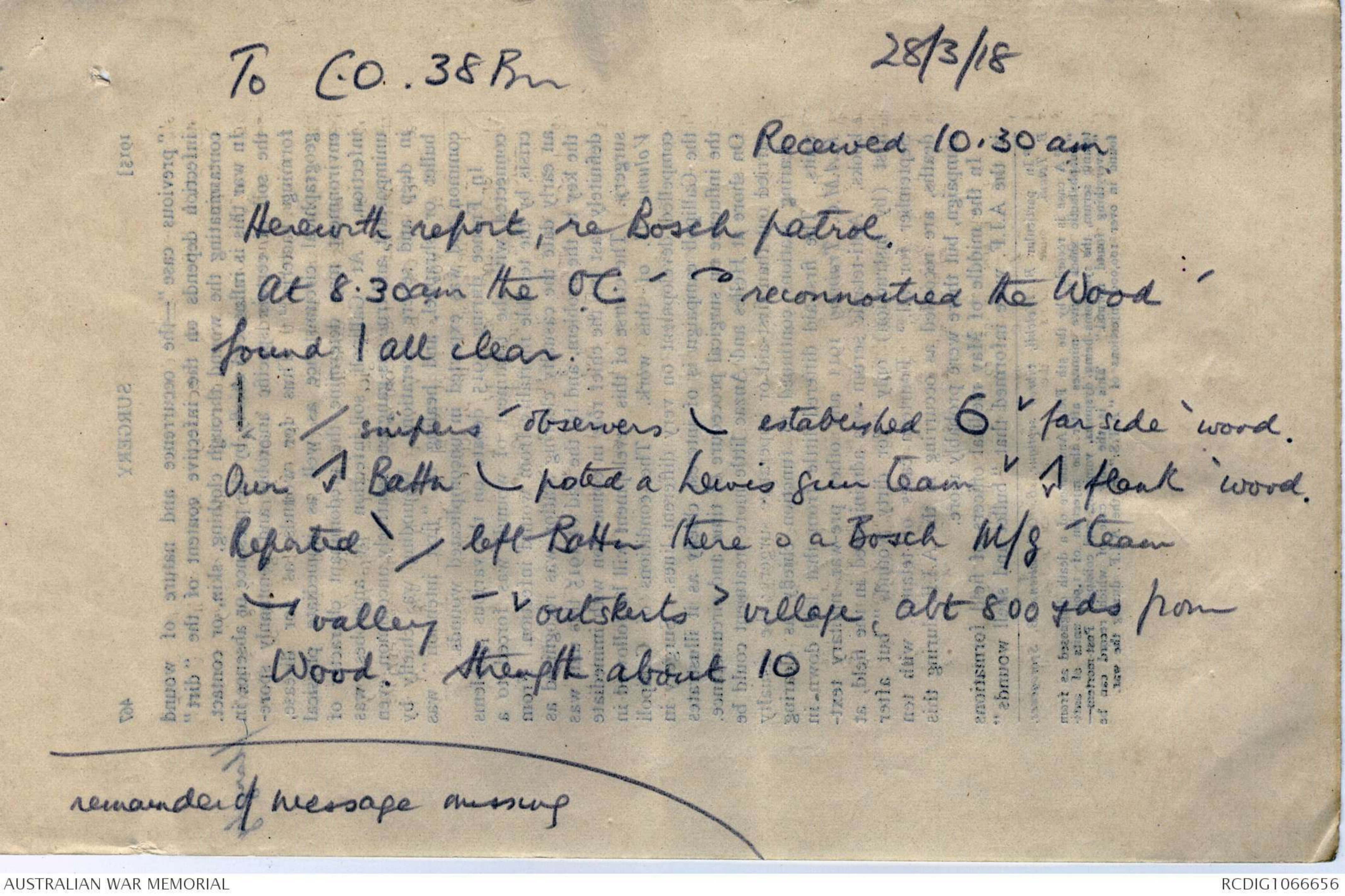
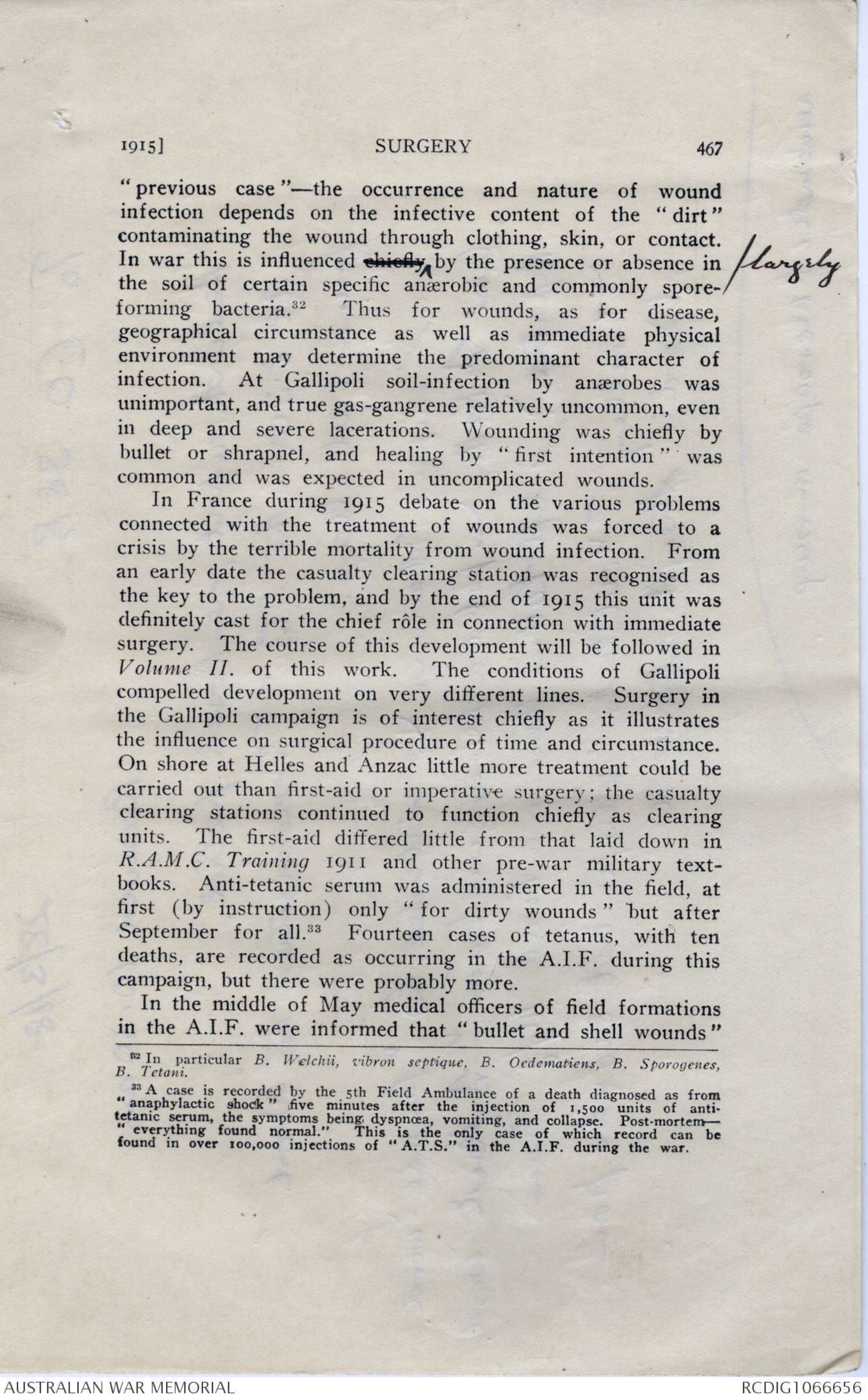

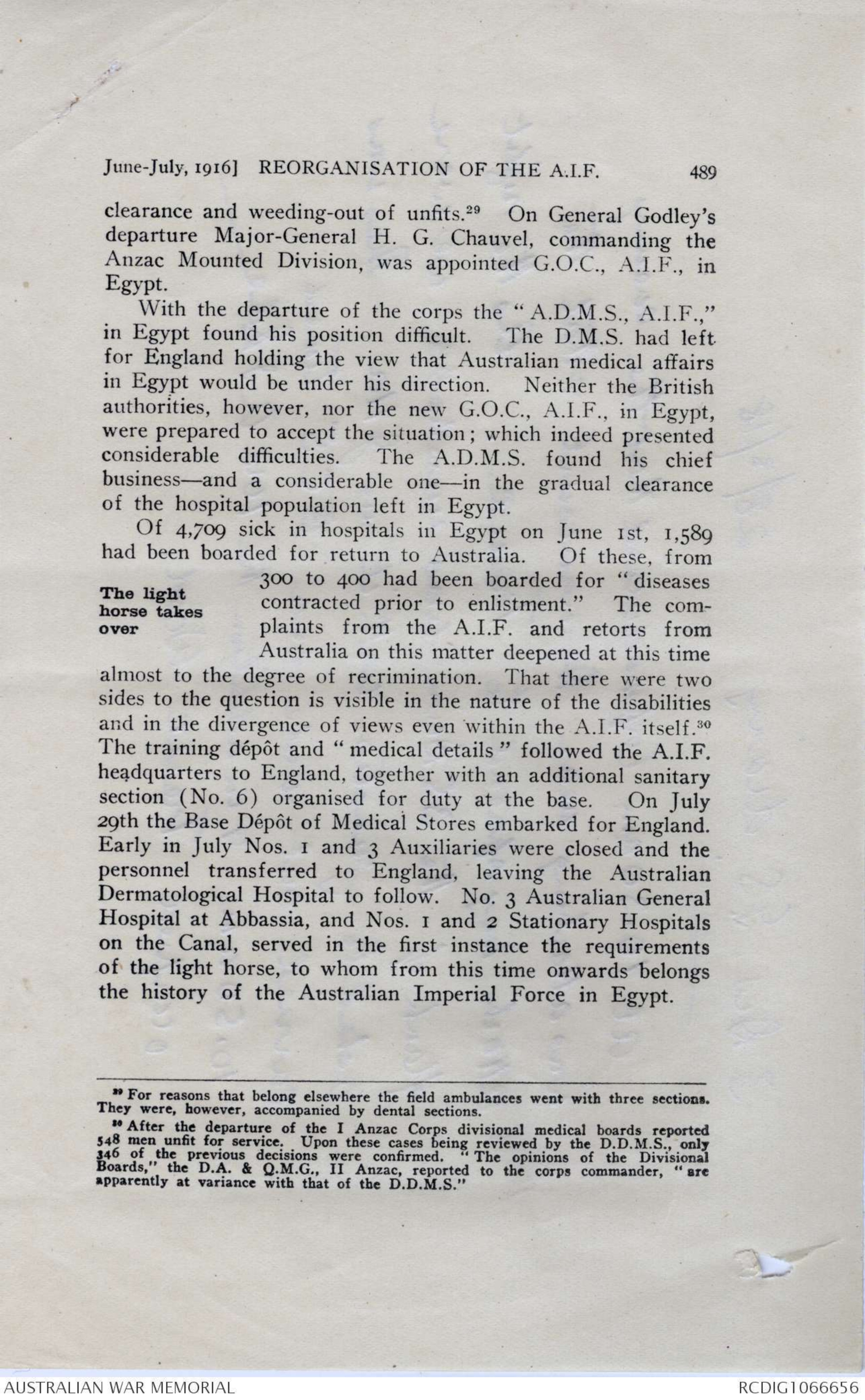



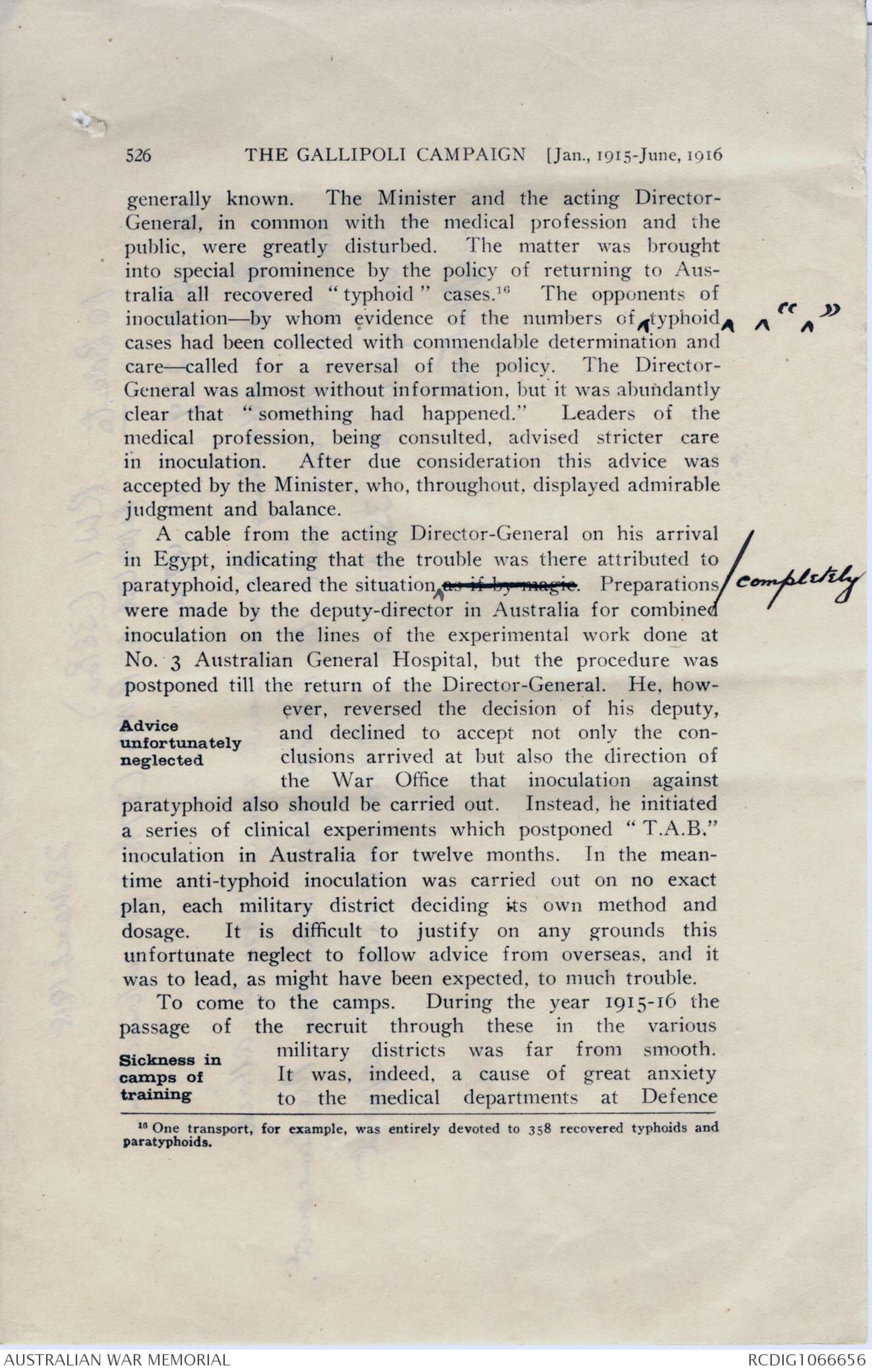
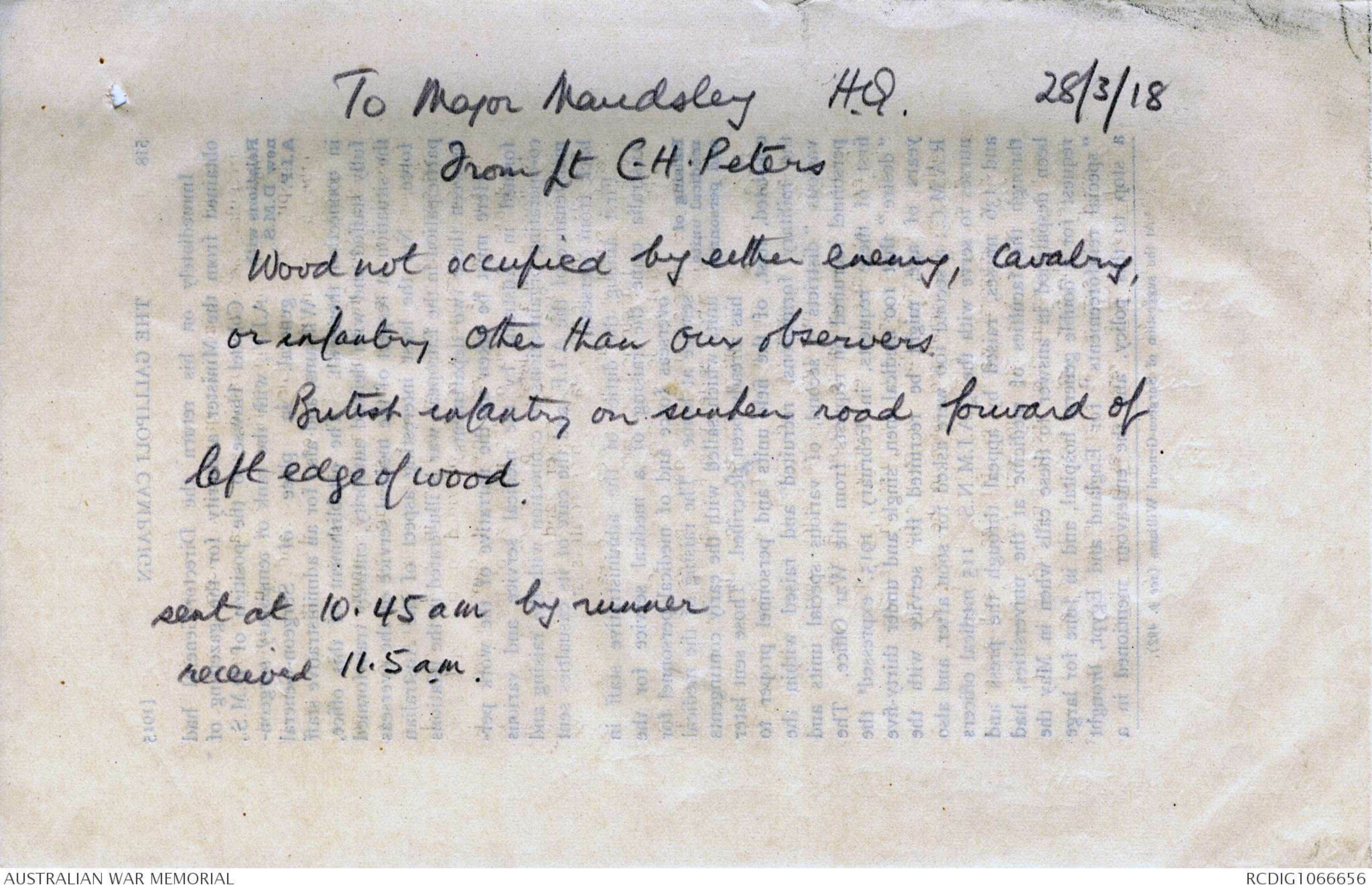
Graph 10
THE “NON- EFFECTIVE” GROUP OF GASTRO- INTESTINAL DISEASES ANALYSED
INTO INDIVIDUAL DISEASE ENTITIES
Diagram - see original document.
28/3/18
To C.O. 38 Bn
Received 10.30 am.
Herewith report, re Bosch patrol.
At 8.30am the O.C. and men reconnoitred the Wood and
found it all clear.
Our snipers and observers have established themselves on the far side of wood.
Our arty Battn have posted a Lewis gun team on the right flank of wood.
Reported by our left Battn there is a Bosch M/g team
in the valley and on the outskirts of the village abt 800 yds from
Wood. Strength about 10
[*remainder of message missing*]
1915] SURGERY 467
"previous case"—the occurrence and nature of wound
infection depends on the infective content of the "dirt"
contaminating the wound through clothing, skin, or contact.
In war this influenced chiefly ∧largely by the presence or absence in
the soil of certain specific anaerobic and commonly spore-forming
bacteria. 32 Thus for wounds, as for disease,
geographical circumstance as well as immediate physical
environment may determine the predominant character of
infection. At Gallipoli soil-infection by anaerobes was
unimportant, and true gas-gangrene relatively uncommon, even
in deep and severe lacerations. Wounding was chiefly by
bullet or shrapnel, and healing by "first intention" was
common and was expected in uncomplicated wounds.
In France during 1915 debate on the various problems
connected with the treatment of wounds was forced to a
crisis by the terrible mortality from wound infection. From
an early date the casualty clearing station was recognised as
the key to the problem, and by the end of 1915 this unit was
definitely cast for the chief rôle in connection with immediate
surgery. The course of this development will be followed in
Volume II. of this work. The conditions of Gallipoli
compelled development on very different lines. Surgery in
the Gallipoli campaign is of interest chiefly as it illustrates
the influence on surgical procedure of time and circumstance.
On shore at Helles and Anzac little more treatment could be
carried out than first-aid or imperative surgery; the casualty
clearing stations continued to function chiefly as clearing
units. The first-aid differed little from that laid down in
R.A.M.C. Training 1911 and other pre-war military text-books.
Anti-tetanic serum was administered in the field, at
first (by instruction) only "for dirty wounds" but after
September for all.33 Fourteen cases of tetanus, with ten
deaths, are recorded as occurring in the A.I.F. during this
campaign, but there were probably more.
In the middle of May medical officers of field formations
in the A.I.F. were informed that "bullet and shell wounds"
32 In particular B. Welchiii, vibron septique, B. Oedematiens, B. Sporogenes,
B. Tetani.
33 A case is recorded by the 5th Field Ambulance of a death diagnosed as from
"anaphylactic shock" five minutes after the injection of 1,500 units of anti-tetanic
serum, the symptoms being dyspnoea, vomiting, and collapse. Post-mortem -
"everything found normal." This is the only case of which record can be
found in over 100,000 injections of "A.T.S." in the A.I.F. during the war.
3 Div. G.S. diary 28/3/18
At 10.30 a.m. Corps advised that the enemy
was attacking near Dernancourt & that the
attack may spread to Treux. As the right
flank of the 35 Divn was unreliable we were
asked to junction with it in J 11a. This was
carried out vide our EC5 timed
10.50 a.m. & in addition the 10th A I Bde
occupied Treux Wood.
June-July, 1916] REORGANISATION OF THE A.I.F. 489
clearance and weeding-out of unfits.29 On General Godley's
departure Major-General H.G. Chauvel, commanding the
Anzac Mounted Division, was appointed G.O.C., A.I.F., in
Egypt.
With the departure of the corps the "A.D.M.S., A.I.F.,"
in Egypt found his position difficult. The D.M.S. had left
for England holding the view that Australian medical affairs
in Egypt would be under his direction. Neither the British
authorities, however, nor the new G.O.C., A.I.F., in Egypt,
were prepared to accept the situation; which indeed presented
considerable difficulties. The A.D.M.S. found his chief
business - and a considerable one - in the gradual clearance
of the hospital population left in Egypt.
Of 4,709 sick in hospital in Egypt on June 1st, 1,589
had been boarded for return to Australia. Of these, from
300 to 400 had been boarded for "diseases
The light contracted prior to enlistment." The
horse takes complaints from the A.I. F. and retorts from
over Australia on this matter deepened at this time
almost to the degree of recrimination. That there were two
sides to the question is visible in the nature of the disabilities
and in the divergence of views even within the A.I.F. itself.30
The training dépôt and "medical details" followed the A.I.F.
headquarters to England, together with an additional sanitary
section (No. 6) organised for duty at the base, On July
29th the Base Dépôt of Medical Stores embarked for England.
Early in July Nos. 1 and 3 Auxiliaries were closed and the
personnel transferred to England, leaving the Australian
Dermatological Hospital to follow. No. 3 Australian General
Hospital at Abbassia, and Nos. 1 and 2 Stationary Hospitals
on the Canal, served in the first instance the requirements
of the light horse, to whom from this time onwards belongs
the history of the Australian Imperial Force in Egypt.
29 For reasons that belong elsewhere the field ambulances went with three sections.
They were, however, accompanied by dental sections.
30 After the departure of the I Anzac Corps divisional medical boards reported
548 men unfit for service. Upon these cases being reviewed by the D.D.M.S., only
346 of the previous decisions were confirmed. "The opinion of the Divisional
Boards," the D.A. & Q.M.G., II Anzac, reported to the corps commander, "are
apparently at variance with that of the D.D.M.S."
3 Div. to 10 Bde 28/3/18
10.50 a.m.
EC5. Germans attacking Dernancourt
Expected he may attack line Dernancourt-Treux
from direction Morlancourt. 10 A I B will
join up with the 35 Div in J 11a. – – – –
488 THE GALLIPOLI CAMPAIGN [Mar.-June, 1916
Egyptian Army Barracks, Abbassia, a huge building selected
by the acting D.G.M.S., Australia, while in Egypt.27 Fitted
up with the aid of the Australian Red Cross this formed
one of the best Australian general hospitals organised
during the war. In succession Nos. 2 and 1 General
Hospitals were closed, and left for France. With No. 1 went
the A.D.M.S. 2 of the medical headquarters, Lieutenant-Colonel
T.E.V. Hurley, who arrived in France on March
31st under instructions "to furnish the British authorities
with information concerning the A.I.F. medical units and
organisation." No. 2 Auxiliary and the Australian Convalescent
Dépôt, Helouan, were closed at the beginning of
April, the staff being absorbed in the A.A.M.C. details.
These events practically synchronised with an important
change in the system of command in Egypt. On March 19th
"E.E.F." dual control of the British forces in that
formed region ended by the formation of the
"Egyptian Expeditionary Force" under
command of Sir Archibald Murray. The Levant Base having
ceased to function, the P.D.M.S. returned to the United
Kingdom, as also did Sir John Maxwell, commander of the
Force in Egypt, and his D.M.S., Surgeon-General Ford.
With the departure of I Anzac Corps the full significance
of the transfer to France became evident. At two important
The new conferences28 with the "Imperial" authorities
medical in London the decision had been reached that
dispositions the administrative headquarters of the A.I.F.
and the medical base for the troops in France
should be in England. A cable from Australia instructed that
the new D.M.S., A.I.F., should proceed to England at once in
order "to personally arrange regarding hospital accommodation."
He embarked on April 19th, leaving an "A.D.M.S.,
A.I.F.," in Egypt to represent him. A.I.F. headquarters left
for England on May 10th, leaving under the "G.O.C., A.I.F.,
in Egypt" a cadre to which the A.D.M.S. was attached.
The II Anzac Corps (4th and 5th Divisions), after eight
weeks on the "Canal Defences," followed I Anzac to France,
commencing its move on June 1st and undergoing a like
27 The hotels were found to make bad hospitals.
28 This matter will be referred to in Vol. II.
28 March 1918
10 Bde to RW 1 (38 Bn)
Repeated to RWG (37 Bn) for information.
No. BM 239 10.47 a.m.
Boche attacking Dernancourt & may possibly attack
line from Dernancourt to Treux from direction Morlancourt.
Join up with 35 Div in J 11a at once & report
completion
526 THE GALLIPOLI CAMPAIGN [Jan., 1915-June, 1916
generally known. The Minister and the acting Director-General,
in common with the medical profession and the
public, were greatly disturbed. The matter was brought
into special prominence by the policy of returning to Australia
all recovered "typhoid" cases.16 The opponents of
inoculation - by whom evidence of the numbers of ∧"typhoid ∧"
cases had been collected with commendable determination and
care - called for a reversal of the policy. the Director-General
was almost without information, but it was abundantly
clear that "something had happened." Leaders of the
medical profession, being consulted, advised stricter care
in inoculation. After due consideration this advice was
accepted by the Minister, who, throughout, displayed admirable
judgment and balance.
A cable from the acting Director-General on his arrival
in Egypt, indicating that the trouble was there attributed to
paratyphoid, cleared the situation ∧completely as if by magic. Preparations
were made by the deputy-director in Australia for combined
inoculation on the lines of the experimental work done at
No. 3 Australian General Hospital, but the procedure was
postponed till the return of the Director-General. He, however,
Advice reversed the decision of his deputy,
unfortunately and declined to accept not only the conclusions
neglected arrived at but also the direction of
the War Office that inoculation against
paratyphoid also should be carried out. Instead, he initiated
a series of clinical experiments which postponed "T.A.B."
inoculation in Australia for twelve months. In the meantime
anti-typhoid inoculation was carried out on no exact
plan, each military district deciding its own method and
dosage. It is difficult to justify on any grounds this
unfortunate neglect to follow advice from overseas, and it
was to lead, as might have been expected, to much trouble.
To come to the camps. During the year 1915-16 the
passage of the recruit through these in the various
Sickness in military districts was far from smooth.
camps of It was, indeed, a cause of great anxiety
training to the medical departments of Defence
16 One transport, for example, was entirely devoted to 358 recovered typhoids and
paratyphoids.
To Major Maudsley H.Q. 28/3/18
From Lt C.H. Peters
Wood not occupied by either enemy, cavalry,
or infantry other than our observers.
British infantry on sunken road forward of
left edge of wood.
sent at 10.45 am by runner
received 11.5 a.m.
 Sandy Mudie
Sandy MudieThis transcription item is now locked to you for editing. To release the lock either Save your changes or Cancel.
This lock will be automatically released after 60 minutes of inactivity.